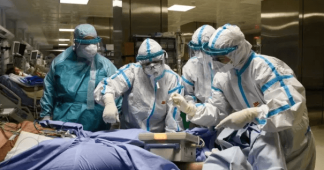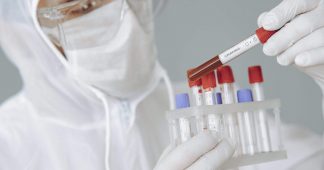“We are on an absolutely catastrophic path,” said a COVID-19 doctor at America’s best-prepared hospital
By Ed Yong
Perhaps no hospital in the United States was better prepared for a pandemic than the University of Nebraska Medical Center in Omaha.
After the SARS outbreak of 2003, its staff began specifically preparing for emerging infections. The center has the nation’s only federal quarantine facility and its largest biocontainment unit, which cared for airlifted Ebola patients in 2014. The people on staff had detailed pandemic plans. They ran drills. Ron Klain, who was President Barack Obama’s “Ebola czar” and will be Joe Biden’s chief of staff in the White House, once told me that UNMC is “arguably the best in the country” at handling dangerous and unusual diseases. There’s a reason many of the Americans who were airlifted from the Diamond Princess cruise ship in February were sent to UNMC.
In the past two weeks, the hospital had to convert an entire building into a COVID-19 tower, from the top down. It now has 10 COVID-19 units, each taking up an entire hospital floor. Three of the units provide intensive care to the very sickest people, several of whom die every day. One unit solely provides “comfort care” to COVID-19 patients who are certain to die. “We’ve never had to do anything like this,” Angela Hewlett, the infectious-disease specialist who directs the hospital’s COVID-19 team, told me. “We are on an absolutely catastrophic path.”
To hear such talk from someone at UNMC, the best-prepared of America’s hospitals, should shake the entire nation. In mid-March, when just 18 Nebraskans had tested positive for COVID-19, Shelly Schwedhelm, the head of the hospital’s emergency-preparedness program, sounded gently confident. Or, at least, she told me: “I’m confident in having a plan.” She hoped the hospital wouldn’t hit capacity, “because people will have done the right thing by staying home,” she said. And people did: For a while, the U.S. flattened the curve.
But now about 2,400 Nebraskans are testing positive for COVID-19 every day—a rate five times higher than in the spring. More than 20 percent of tests are coming back positive, and up to 70 percent in some rural counties—signs that many infections aren’t being detected. The number of people who’ve been hospitalized with the disease has tripled in just six weeks. UNMC is fuller with COVID-19 patients—and patients, full stop—than it has ever been. “We’re watching a system breaking in front of us and we’re helpless to stop it,” says Kelly Cawcutt, an infectious-disease and critical-care physician.
Cawcutt knows what’s coming. Throughout the pandemic, hospitalizations have lagged behind cases by about 12 days. Over the past 12 days, the total number of confirmed cases in Nebraska has risen from 82,400 to 109,280. That rise represents a wave of patients that will slam into already beleaguered hospitals between now and Thanksgiving. “I don’t see how we avoid becoming overwhelmed,” says Dan Johnson, a critical-care doctor. People need to know that “the assumption we will always have a hospital bed for them is a false one.”
What makes this “nightmare” worse, he adds, “is that it was preventable.” The coronavirus is not unstoppable, as some have suggested and as New Zealand, Iceland, Australia, and Hong Kong have resoundingly disproved—twice. Instead, the Trump administration never mounted a serious effort to stop it. Whether through gross incompetence or deliberate strategy, the president and his advisers left the virus to run amok, allowed Americans to get sick, and punted the consequences to the health-care system. And they did so repeatedly, even after the ordeal of the spring, after the playbook for controlling the virus became clear, and despite months of warnings about a fall surge.
Not even the best-prepared hospital can compensate for an unchecked pandemic. UNMC’s preparations didn’t fail so much as the U.S. created a situation in which hospitals could not possibly succeed. “We can prepare over and over for a wave of patients,” says Cawcutt, “but we can’t prepare for a tsunami.”
Read more at www.theatlantic.com/











